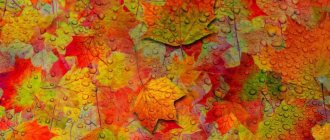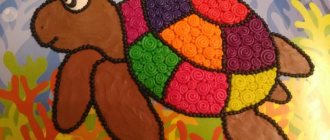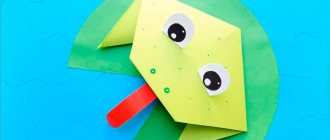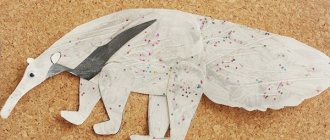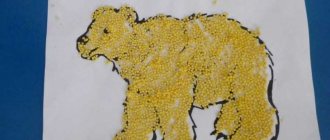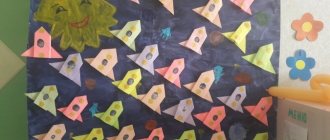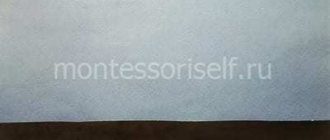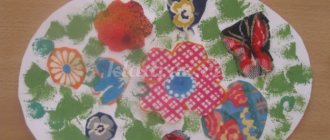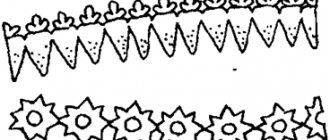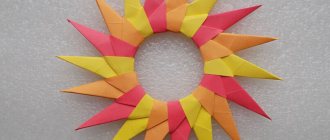What and how to make an applique from leaves
What we need:
- 1. Natural material: leaves of various sizes, shapes and colors (they can be dried in advance), twigs, flowers, herbs, seeds.
- 2. Colored paper, felt, glue, scissors, paints, pencils, cardboard.
- 3. Varnish can also be useful to fix the finished work and give it shine.
How to work with leaves:
To start working on crafts from leaves, they must first be dried. This can be done between the leaves of books, or using an iron. Store the leaves between the pages of books or newspapers.
Types of applications made from natural materials
- Overlay applique. A simple look that does not require additional work with leaves - they are glued to a sheet of paper or cardboard, creating the intended plot. These can be animals, trees, mushrooms. You can add some details.
- Mosaic or modular application. This technique involves gluing leaves that are identical or similar in shape. This way you can make a bird's tail or fish scales.
- Symmetrical applique. In this case, it is necessary to select similar leaves to create mirror images. This way you can make an image in water, a butterfly, a dragonfly.
- Ribbon applique. A type of symmetrical applique, but in this case you can make several similar images.
- Silhouette applique. The leaves are trimmed to create the desired pattern or shape.
Children become interested in applications and crafts even at the stage of collecting material. Kids like to collect leaves on the paths while walking, look for cones and chestnuts. Therefore, it will not be difficult to persuade your child to use all this to create a beautiful applique.
Preparatory group. Senior preschool age. Children 6-7 years old
Summary of a lesson on appliqué in the preparatory group “Miracle Tree” (clothes, shoes, hats) Summary of a lesson on appliqué in the preparatory group “Miracle Tree”
Goals: continue to strengthen the skill of working with a template, carefully tracing with a simple pencil; continue to work on developing the ability to symmetrically cut out parts along drawn lines and work with glue;…
Lesson on appliqué in the preparatory group “The corner of the planet where we live” Summary of the lesson on “artistic and aesthetic development”
— Collective
application on the topic “The corner of the planet where we live”
for children of the preparatory group
(break technique)
Prepared by: teacher Glazova S.N. Goal: To reinforce the idea that our country is only...
Simple autumn applications for kids
It is always more difficult to work with the youngest children and you need to find an approach to them. They cannot be forced to sit on one job for a long time. Therefore, the craft should be as simple as possible. How to make an interesting autumn-themed craft in just a few minutes to inspire your child to continue.
It seems that nothing simpler than this application can be found.
Take one beautiful yellow leaf. Turn the wide part down. Glue it onto cardboard. You can finish drawing the arms and legs, and insert the drawn umbrella into your hand.
A leaf like this with eyes will look funny. They can be made from plasticine or cardboard, or maybe you can find small buttons and glue them on. Don't forget to make it cheerful by drawing a smile.
Autumn from palms: applique
We will need:
- Colored paper
- Scissors
- Glue
- Sheet of cardboard
1. We need brown paper to create a tree trunk.
2. Trace children's palms on colored paper, making several multi-colored blanks.
3. Glue the tree trunk and leaves onto the cardboard
Options for appliqué on the theme of autumn made from palms:
Application for the younger group: autumn tree
Another applique option for the little ones is a tree.
It’s easy to make: collect thin branches of approximately the same size and glue them in a bunch on cardboard. We lay the leaves above like a crown. You will get an autumn tree from leaves.
You can make a torn applique from colored paper.
Using cereals you can make a beautiful autumn tree.
Paint the millet with different colors. Draw the trunk and branches. Using PVA, glue the cereal to create a tree crown.
Hedgehog
Applications for the little ones are creativity, where the abilities of even the tiniest fidget are taken into account. And this example with the “hedgehog” is just right for toddlers who, by the age of three, still cannot cut and glue, but they will be great at participating in the work. How?
- There are two options for preparing to make this applique for kids.First
. We trace the baby's palm on a sheet of black or brown paper. Cut it out. Glue it. Four palms will be enough.Second option
. Or we use finger paints. The child dips his palm, and we help him put his palm in this way several times, at different angles in the upward direction, to make a fan. - Cut out something like a boat from paper of the same color. This is the body and nose of the hedgehog (cut out a small circle and glue the “nose” to the edge of the muzzle).
- We place the body under the “needles”.
- You can draw a mouth and an eye, or make semicircles from red and white paper. Don't forget about the pupils.
- Paper applications would be incomplete without a plot. We come up with a story with the baby. Our hedgehog is coming from the forest, so we’ll cut out and glue his “prey”: an apple and a mushroom.
- We complement the paper applique with small black paws.
Application for the younger group on the theme of autumn
Applications made from natural materials in kindergarten are not very complicated. For them you can use not only leaves, but seeds, acorns, twigs. Colored paper and cardboard are also used.
Autumn flower applique
Beautiful colorful leaves that fall to the ground from trees can be transformed into an autumn flower. You can create such a flower using glue and a sheet of cardboard.
If one flower is not enough, then you can make a vase with flowers from autumn leaves.
Beautiful umbrellas will be made from pieces of colored paper. This type of applique is called cut-off.
GCD for the application “Sheep with lamb”
- January 14, 2014
Competition “My Pedagogical Initiative - 2013”
Nomination “Methodological work in preschool educational institutions”
Notes on the application for the preparatory school speech therapy group “Sheep with a lamb”
Goal: to consolidate the skills of silhouette cutting along a drawn contour using a stencil; various techniques of applique (tearing, volumetric applique) - development of a sense of color and harmony.
Tasks:
- Educational: learn to place decorative elements (lumps) in certain parts of the silhouette. Systematize children’s knowledge on the lexical topic “Domestic animals and their cubs”
- Correctional and developmental: develop spatial and figurative thinking, fine motor skills.
- Educational: cultivate love for animals.
Equipment: illustrations depicting a sheep and lamb; colored cardboard (green or blue), equal in size to ½ landscape sheet; 2 white paper napkins; sheep and lamb stencils; white or brown paper; dark pencil or felt-tip pen; scissors; PVA glue, tray, socket with a damp sponge, socket for glue, glue brush, oilcloth, cloth.
Preliminary work: repeat the topic “Domestic animals and their cubs” with the children. Ask what benefits sheep bring. Consider sheep wool products, illustrations; draw a sheep, sculpt it from plasticine.
GCD move
– Hello guys. Today I want to invite you to the barnyard, where various domestic animals live with their children. But first, I would really like us to remember together what kind of pets there are (children’s answers).
- Well done! Everyone was named. Now let's do gymnastics for our fingers and wake up our hands. I will say the words and show the movements, and please repeat after me.
Finger gymnastics “Satisfied animals”
– Well done! Our fingers are awake and ready to work. Now, please, look at the picture (illustration demonstration). Who is depicted here (children's answers)?
- Right. This is a sheep. And a baby sheep is called a lamb. Who knows what benefits sheep bring us (children’s answers)?
- Right. You're all right. Please listen to my story.
A male sheep is called a ram. It has large, spiraling horns. The female is called a sheep, she does not have horns. A baby sheep is called a lamb. If there are several cubs, these are lambs. A ewe can give birth to one to five lambs.
Sheep live in a group - a flock - and do not tolerate loneliness well. Where one sheep goes, all the others go. There is no permanent leader in the flock, so a goat is often taken out to pasture along with the sheep. He leads the flock and leads the sheep home.
The building where sheep are kept is called a shed. The sheep are fed grass and hay. Sheep tolerate heat and cold well, so they are kept on pastures almost all year round. Open-air pens are built for sheep - quiet. A person who tends a flock of sheep is called a shepherd. The shepherd is usually helped by herding dogs. They herd sheep, guide them, search for lost ones, and protect sheep from predators.
The sounds sheep make are called bleats. Sheep come in different colors: black, white, red, gray. There is a Romanov breed of sheep - they have gray wool on their body, and black wool on their head and legs.
People raise sheep mainly for their wool. Sheep are sheared 1-2 times a year, collecting up to 6 kilograms of wool from one sheep. Very warm yarn, blankets, felt boots, and mattresses are made from sheep wool. They also get meat, fat tail fat, and milk from sheep. Doctors in Ancient Egypt, Greece and Rome recommended drinking sheep's milk as a medicine. Sheep's milk cheese is also considered very healthy. The oldest recipe for sheep's cheese that has come down to us is 2000 years old.
– Today I would like to invite you to make an applique. What do you think is the difference between applique and drawing (children's answers)? Right. When we do appliqué, the picture is not drawn, but assembled from parts that are secured with glue. Please look at what is on your tables. Glue, napkins, colored paper, colored cardboard, glue brush. But before we start work, let's take a little rest.
Physical school
– Have you rested? Now let's do the application.
Children begin the task, the teacher monitors completion, helping children who have difficulty.
Work order
1. Prepare lumps from a white napkin in advance. The lumps should be approximately equal, with a diameter of 3-5 mm.
2. Transfer the animal stencils onto a sheet of white or brown paper, cut along the contour and place on a cardboard base.
3. Glue on the silhouettes of a sheep and a lamb.
4. Glue lumps onto the forehead and back of the animals (when gluing, dip each lump in turn into glue and glue close to each other).
5. Use a dark felt-tip pen or pencil to draw eyes and a nose.
Lesson summary
Cleaning the workplace. Demonstration of their works by children; choose the most neat and beautiful works with the children.
- Guys, what did we do today? What did you like most about the lesson? What do you remember? (Children's answers).
– Well done, you all tried your best and you did a good job. This concludes our lesson. Thanks to all.
Literature
1. Malysheva A. N., Ermolaeva N. V. Application - Yaroslavl: Academy of Development: Academy Holding, 2002.
2. Didactic cards for familiarization with the world around us “Domestic animals and their cubs.”
Author: Kleeva Ekaterina Viktorovna, teacher of fine arts activities at MB Preschool Kindergarten No. 36 of a combined type, Novokuznetsk, Kemerovo region.
Autumn applications: preparatory group
Applications made from natural materials in kindergarten occupy a large part of the children's development program. Autumn gifts of nature open up many possibilities for activities with children. Therefore, autumn fairs are a place where you can show off your talents.
You can invite the children to come up with a real composition of leaves.
If you combine drawing and applique, you can make such a cute hedgehog from seeds.
Using flower petals and grass sprigs, you can make beautiful applications
Crafts for March 8
Tulips are very delicate and graceful flowers. And such crafts for March 8, made in the preparatory group, will be an ideal gift for mothers.
These flowers can be put in a bouquet or given one at a time - in any case they will look very beautiful. Materials to prepare:
- Disposable plastic spoons,
- One flower will require four pieces,
- Scotch tape and colored corrugated paper,
- Shades should be green and red.
For one flower you need up to one meter of each type of paper. Wrap red paper around the spoons, and wrap the handle of the spoon in green paper and use tape to secure it. Attach leaves cut from green paper.
Beautiful flowers are ready, you can arrange them as a bouquet in a basket.
Leaf applications: senior group
Leaves are the most accessible material for embodying your talent in creating bright and colorful paintings and applications on the theme of autumn. By choosing leaves of the correct shape, you will get a variety of animals and insects.
Applique: fox made of colored paper
It is very convenient to make applications with children using ready-made templates. To do this, just print the blank and cut it out.
Another version of the fox template made from colored paper made of geometric shapes.
The fox cubs may turn out completely different, but adding them with a drawing will result in interesting works:
Unusual three-dimensional applique made of colored paper
Applique Autumn tree: middle group
The change in nature in autumn is noticeable to everyone and even children see the difference when the trees turn yellow.
We will need:
- Sheet of cardboard
- Colored paper
- Glue
- Scissors
Create a tree trunk and branches from brown construction paper.
Glue the tree onto a background sheet of cardboard, having previously made a tree crown
Glue leaves of different colors onto the branches of the tree.
Autumn mushroom: applique
You can always find mushrooms under a tree in the fall, so learning how to make mushroom appliques is also useful.
Mushroom cutting templates for appliques
If classic appliqués are already boring and you want some variety, then you can combine drawing and gluing natural materials. Such works are quite suitable as applications made from natural materials for elementary school.
Children can already give a gift to their mother by drawing her portrait and adding leaves and other natural materials to the picture.
For the little ones
Who said that plot application is difficult? Even the younger group can cope with some types of applications. Now we will create a beautiful basket with flowers in it.
What we may need for the application:
- Colored thin paper;
- Cardboard;
- Pencil;
- Stencils;
- Glue.
Step 1 . If possible, draw a basket, there is no way to draw it, then you can print it from our website. Choose the color yourself, just remember that there will be flowers on her, and she is the background for them.
Glue the basket to a thicker paper base or cardboard. Then our difficult volumetric paper applique will hold firmly. Let's start creating.
Step 2 . Using a stencil, cut out circles from a sheet of paper. A stencil can be different objects: small cups, coins, round bottles, cups.
We take paper of bright colors, since the pictures should be colorful and joyful. Just the right entertainment for children 2-3 years old, exactly what they love.
Step 3 . Place a pencil on the colored part, in the middle of the circle, and wrap paper around it. In order for us to get voluminous applications, it is enough to even slightly press the circles against the rod.
Step 4 . Without removing the pencil, dip the center of the future bell or orchid into glue and press it with a pencil. You can continue and stick a second circle of smaller diameter into the very center in the same way to create voluminous poppies and daisies.
You can also keep children occupied with plasticine, for example, Hey Clay Sticky Packs. It differs from the usual one in that it does not stick to hands or furniture, and is much brighter and easier to mold. After 24 hours it hardens and becomes a toy. Includes a free application for step-by-step modeling training.
Autumn applications made from natural materials
With the help of activities with natural materials, you can also strengthen children’s understanding of changing weather conditions, explain to them what the seasons are and what happens with their changes.
The late autumn applique will help reveal to the child a new stage of nature that precedes winter weather. After all, in late autumn we observe a cooling, the leaves become less and less and the last leaves are blown away by the wind from the branches of the trees.
Application: autumn has come
An application on this topic will reveal to the child the concept of how summer changes to autumn, what happens in nature during this period. After all, there are still many leaves on the trees, some green, but also red, orange and burgundy.
Take unnecessary puzzle pieces, paint them with different colors, whatever color you want the leaves on the tree to be. The tree trunk can be drawn, or it can be glued from paper.
Volumetric applique on the theme of Autumn
Autumn is accompanied by rains and an attribute that can be found in any apartment is an umbrella. It’s quite simple to depict an umbrella and create a voluminous applique on an autumn theme.
Take a white sheet of paper. Starting from the corner, draw any pattern. You need to cut the corner in a semicircle. We fold the cut out part of the sheet like an accordion.
Glue this part onto a piece of paper
You can draw raindrops on a piece of paper.
You can also use a ready-made template to make an umbrella.
We cut out the template, having previously printed it, and make patterns on it.
Just like in the previous version, we fold the umbrella blank like an accordion
You can make such funny umbrellas
Draw or print out an image of a girl and glue an umbrella to her hand.
Leaves applique: autumn
It is not necessary to use only whole leaves for appliqués. There is a separate direction in creativity - broken applique. You can use not only leaves, but also colored paper. Its principle is that the silhouette of the figure is created from torn material.
To make the application, we will need:
- Sheet of cardboard
- Leaves
- Glue
- Dye
Dried leaves must be crumbled.
Draw a tree trunk and branches on cardboard.
Once the paint is dry, apply glue to the trunk and branches where you want the leaves to be.
Sprinkle pieces of leaves onto the glue.
Press down the leaves a little to secure.
Shake off excess leaves from the appliqué.
The same tree can be made using colored paper.
It is not so easy to cope with such an application. The main thing here is to choose the right leaves
Applique Autumn bouquet
This craft is quite suitable as a gift for a teacher or mother from a schoolchild. After all, such a bouquet of leaves will last much longer than a fresh bouquet of real flowers.
Pre-dry leaves from different trees. Prepare glue, scissors and a sheet of cardboard.
Form a vase from the leaves by gluing them onto cardboard. And then help your child create a beautiful bouquet of leaves. To make it bright and neat, use light leaves for the craft, without holes or stains.
A vase for an autumn bouquet of leaves can be made from colored paper, or you can create a bouquet not only from leaves and do without a vase.
Autumn paintings, panels: applications
Using the appliqué technique, you can create beautiful and original paintings from a variety of natural materials.
Collect various leaves, twigs and flowers, dry them as a herbarium and start creating real panels and paintings.
The following are perfect for such a picture: moss, straw, spikelets, seeds, small flowers
Painting “Autumn Girl”
Volumetric applications of vegetables and fruits in the preparatory group
Every child will be interested in making a variety of fruits and vegetables out of paper, which they eat from an early age. They can be made as appliqués on paper or in volume.
How to make an apple out of paper
We will need a sheet of red double-sided paper. Fold it in half and cut it. We also fold the halves in half and draw the silhouette of half an apple with a pencil.
Glue the apple halves onto a piece of paper and create a core, stalk and leaf.
Paper crafts
Paper is a very convenient material, working with which allows you to practice many important skills and gives a lot of scope for the child’s imagination.
In order for children to become more diligent, as well as more careful and attentive, pay attention to paper crafts for work in the preparatory group.
Fruit applique: senior group
Making strawberries out of paper
Cut out tails from green paper.
Fold two pieces of red paper in half and cut out a heart.
Glue one part to the base of the sheet, and glue the second along the fold line.
Glue a green tail cut from a template on top and draw dots with a black felt-tip pen.
Volumetric cherries made of paper: applique
From red paper you need to cut 4 circles (diameter 5-6 cm).
Fold the circles in half and cut out the green strip.
Take a green sheet 12*6 cm and cut out the leaves by folding the paper in half
Glue a strip folded in half onto a sheet of cardboard. Glue leaves on top and a cherry on each branch.
Bunch of grapes made of colored paper
paper horse
In the photo of the crafts in the preparatory group you can see an interesting product - a horse made from a paper template.
To work, you will need brown double-sided cardboard, a black felt-tip pen, double-sided black paper, and the presence of scissors, pencil glue and a simple pencil are also important for the work.
In addition, find a horse template on the Internet that you will use for your work.
